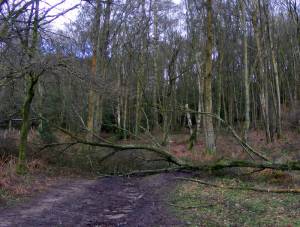
The Winter Season is when we do most of the conservation work on the Lynchmere Commons. The volunteer gang has worked hard this season and despite the near continual rain and snow we’ve been very busy. Now the nesting season is suddenly in full swing (as it’s not snowing this week) we can stand back and admire all of the cutting, felling, burning, thinning, scraping, digging,filming, laying, fencing and mending we’ve been doing but before we do there is just time to fit in a little mowing.
We planted a community orchard a couple of years ago in a sheltered corner of one of the Ridgecap fields that adjoin the commons. These fields are traditional hay meadows and pastures, once the mainstay of every small farm but now very rare and endangered. This is mainly because without being ploughed up and reseeded with modern varieties of grass, and with no fertilisers and pesticides being applied the yield (in terms of grass) is far too low to pay for the monster machinery that now populates our farms and countryside. Likewise we’ve planted up the orchard with traditional apple varieties from Sussex and surrounding counties, all on large and traditional half-standard sized rootstocks rather than the higher yielding and smaller bush varieties.

The orchard is not grazed so we need to cut the grass by hand. Having been a rough corner of the meadow it’s a serious challenge and the first aim is to reduce the tussocks and remove the old thatch of dead plants ready for the new season.
With a little sunshine a tiny bit of coaching in technique with a scythe and a lot of enthusiasm it didn’t take long to get through the orchard – keeping the rakers busy. Andy is using one of my oversized hay rakes – it has a 32inch head,nearly 3 foot, and a 6ft handle which makes it harder to use but once you get used to it you cover a lot of ground. Both Andy and the rake seem to have survived the experience.

With a good turnout (a promise of free food and drink is always a good thing) we had upto 9 scythes out mowing, enough for a team, with several Austrian Scythes a couple of English Scythes and Nick joined us with his original ‘Turk Scythe’. These were first imported from Europe around the 1970’s when manufacture of English scythes stopped. Very light in comparison to the English Scythe. This one has a classic Austrian style blade that we often use today but the handle or snathe is very interesting with it’s straight shaft and fixed handgrips. Very light but only suited to one size of user.

I’m not sure that the scything and raking was the main attraction here, I rather think it was mainly just to work up an appetite for lunch! It was the last task of our winter work programme and so a bit of an end of term party as well as the nature of the work now changes through the summer season.

A good job done. A little bit of exercise, good company and a lunch in the orchard, a nice way to get some fresh air. Of course the job could have been done with a strimmer – but it’s really not so much fun to stand and watch a strimmer, you can’t rake the grass off afterwards and with 9 mowers on the task it was a really quick (if not completely proficient) job.
I find it thought provoking to reflect upon which is really the most efficient way of working, one mower with a petrol strimmer for a dayor two, and Allen Scythe for a few hours or several mowers with scythes and a few rakers and forkers for a couple of hours? This blog isn’t really the best place for discussing this so I’m in the process of opening up a new site ‘The Scythe Grinders Arms‘ to host a wider discussion of environmental issues and my pet rants.
If you live in the Haslemere area and like the idea of working on the Lynchmere Commons and the meadows now and then why not join in with the Volunteer working tasks – you can get more information via the Lynchmerecommons blogsite.
Read Full Post »









































